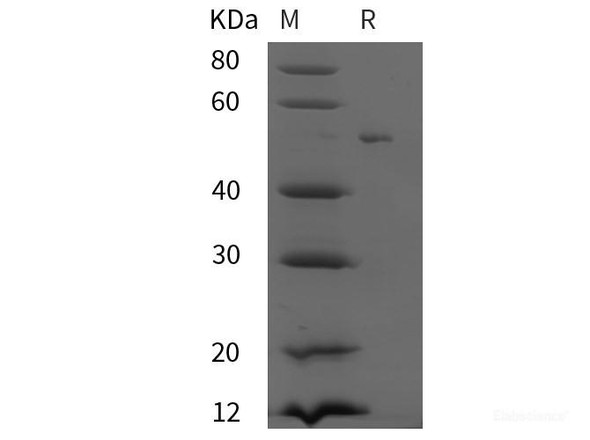Description
| Product Name: | Human Fibronectin Recombinant Protein (GST,His tag) |
| Product Code: | RPES5668 |
| Size: | 20µg |
| Species: | Human |
| Expression Host: | E.coli |
| Synonyms: | Fibronectin, FN1, CIG, ED-B, FINC, FN, FNZ, GFND, GFND2, LETS, MSF |
| Mol Mass: | 46.78 kDa |
| AP Mol Mass: | 50 kDa |
| Tag: | N-GST & C-His |
| Purity: | > 95 % as determined by reducing SDS-PAGE. |
| Endotoxin Level: | Please contact us for more information. |
| Bio Activity: | Testing in progress |
| Sequence: | Gln 32-Arg 230 |
| Accession: | P02751 |
| Storage: | Generally, lyophilized proteins are stable for up to 12 months when stored at -20 to -80°C. Reconstituted protein solution can be stored at 4-8°C for 2-7 days. Aliquots of reconstituted samples are stable at < -20°C for 3 months. |
| Shipping: | This product is provided as lyophilized powder which is shipped with ice packs. |
| Formulation: | Lyophilized from sterile PBS, pH 7.4. Normally 5 % - 8 % trehalose, mannitol and 0.01% Tween80 are added as protectants before lyophilization. Please refer to the specific buffer information in the printed manual. |
| Reconstitution: | Please refer to the printed manual for detailed information. |
| Background: | Fibronectin is a high-molecular weight glycoprotein of the extracellular matrix that binds to membrane-spanning receptor proteins called integrins. Similar to integrins; fibronectin binds extracellular matrix components such as collagen; fibrin; and heparan sulfate proteoglycans. Fibronectin plays a major role in cell adhesion; growth; migration; and differentiation; and it is important for processes such as wound healing and embryonic development. Altered fibronectin expression; degradation; and organization has been associated with a number of pathologies; including cancer and fibrosis. Anastellin binds fibronectin and induces fibril formation. This fibronectin polymer; named superfibronectin; exhibits enhanced adhesive properties. Both anastellin and superfibronectin inhibit tumor growth; angiogenesis and metastasis. Anastellin activates p38 MAPK and inhibits lysophospholipid signaling. |






